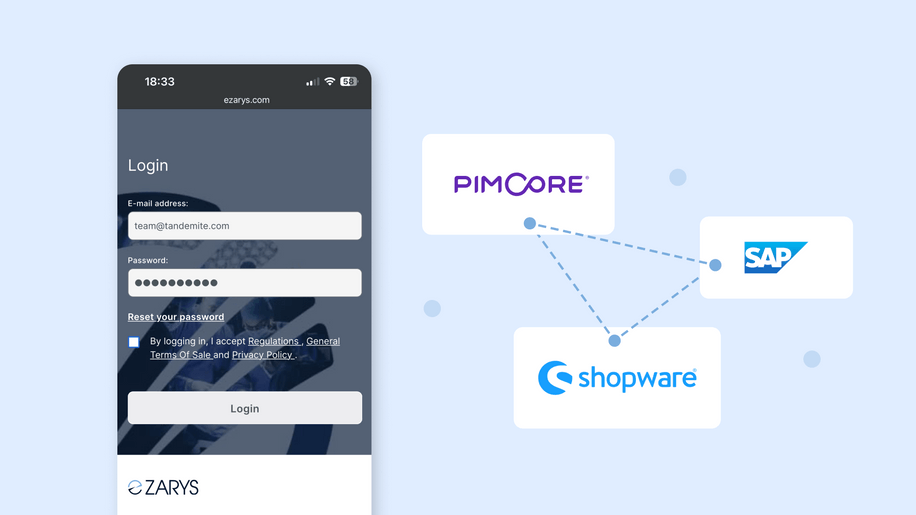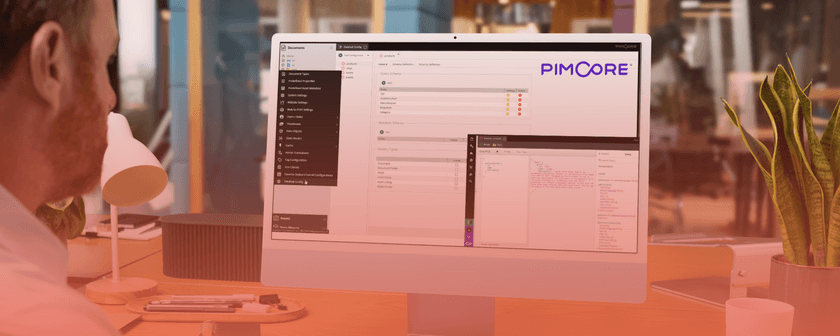How do PIM and ERP transform B2B e-commerce for medical supplies? (the eZARYS story)

In B2B digital sales, precision is everything: product data must be correct, pricing must be clear, and inventory status must remain up to date. If these foundations fail, order handling slows down and requires manual intervention from sales staff. And in medical assortments, it’s not just about customer convenience – compliance with regulations, batch tracking, and patient safety must all be secured.
Here we explain how the Tandemite team engineered data flows and integration processes that enable the eZARYS portal to automatically match the right product, price, and availability with the right customer.
Integration should be seen as automation. In medtech, the goal goes beyond connecting systems. It’s about designing data and workflows so that catalogs, pricing, inventory, compliance documents, and customer permissions organize themselves into a flawless purchasing journey – eliminating manual re-entry and exception handling.
Let’s start by exploring the common context and challenges of medical equipment distributors and manufacturers.
What exactly makes the medical equipment market so demanding (and why a standard shop can’t handle it)
- Product structures are complex: multiple units of measure (piece/pack/carton), conversion logic, and unique EANs for every level.
- Compliance is critical: MDR, UDI, IFUs/leaflets, conformity declarations, classification rules, sterility status – everything must be precise and current.
- True availability means more than “in stock”: batches, expiry dates, reserved items, and similar products must be managed at all times.
- Pricing is contract-driven: execution of framework contracts, budgetary pools, and conditional access to negotiated prices (requiring login).
- Hospitals follow strict procedures: repeatable baskets, checkout, approval workflows, conditional rules that control whether an order can be carried out, and centralized tracking of orders and documents.
The absence of clear role separation between PIM, ERP, and the B2B platform creates operational inefficiencies: manual data transfers, unnecessary reliance on sales calls, and a high probability of publishing product pages that lack complete information.
What is stored in PIM, what belongs in ERP (and what reaches B2B clients through eZARYS)
PIM system („soft” product data)
Focus: The marketing and sales content that shapes how products are presented.
Acts as the source of truth for:
- Optimized names and descriptions with clinical terminology, keywords, and SEO.
- Consistent identifiers linked across all external platforms.
- Clear management of variants and product relationships (bundles, similar items, accessories).
- Reliable technical attributes with validation, dictionaries, and unit standards.
- Structured hierarchies for sales units and automatic conversions (pieces, packs, cartons).
- Rich multimedia and documents: professional photos, datasheets, IFUs/leaflets, all with version control.
- Accurate translations for international markets.
- Compliance: MDR/UDI flags, device classes, sterility status.
- Controlled workflows: from Draft to Published, ensuring completeness and regulatory approval at every stage.
„Our strategy was to keep SAP focused on core processes, without storing soft product data like photos, sales units, base units, or translations.” — Aleksandra Świeczkowska, Head of e-commerce & B2B project, ZARYS International Group
ERP system („hard” operational data)
Focus: The backbone of transactions, inventory, and logistics.
Acts as the source of truth for:
- Prices (both individual and contract), along with discounts, currency settings, and tax rules.
- Inventory, including stock levels, reservations, batch tracking, and expiration dates.
- Contract execution, covering original contract values and remaining allocation.
- Complete logistics data such as units of measure, product dimensions, and volume.
- Controlled availability: rules that define what each customer group can access.
B2B e-commerce platform (the customer interface)
Focus: The place where buyers see, evaluate, and purchase. One of the key success factors is the ability to provide a tailored offer for a single client or an entire customer segment, supported by dedicated promotions, contracts, or special deals.
- Product cards and catalog listings enriched with PIM-managed content.
- Once logged in: customers see ERP-based prices, stock levels, and contract limits. The system enforces purchase thresholds and contracted quantities.
- Full transaction flow: cart, checkout, instant payments, credit lines, and delivery options.
- User tools: search, order and payment history, RMA processing.
Behind the scenes, PIM delivers structure, ERP secures accuracy in pricing and stock, and the B2B platform creates a smooth end-to-end experience.

What role can a PIM-ERP-B2B architecture play in addressing the key challenges of medtech?
Codes, classifications, and product identification form the data model that carries regulatory alignment
A PIM system tailored to healthcare cannot rely only on basic product names and photos. It needs to hold detailed identifiers, codes, risk classification, sterility status, usage type (single-use or reusable), compatibility, and accessories. These data points require clear taxonomies, validation rules, and consistent mapping to language versions and local markets.
PIM’s core task is to create consistency: it defines packaging hierarchy (unit, pack, carton, pallet) with EAN at each level, and manages cross-product links like „substitute/equivalent” and „compatible with.”
In turn, the ERP system can execute flawless stock and batch accounting, and the B2B channel can provide suitable substitutes in case of shortages. Experienced partners know the right sequence: first workshops with the client, then data modeling – guaranteeing smoother rollouts and fewer changes in the future.
Documents, eIFUs and compliance – automated, secure and audit-ready
In medical B2B, supporting documents such as leaflets, eIFUs, certificates, declarations, and artworks form a mandatory compliance layer. They’re not „just another PDF.”
Modern PIM systems track every version with validity dates, languages, and market assignments. Smart workflows automatically block product publishing until the right file is uploaded and approved. Automated alerts highlight upcoming expirations, while B2B buyers always access the most recent, approved version. Seamless integration instantly halts sales in ERP and channels if a product’s documentation becomes incomplete – delivering real safeguards against compliance risks and audit surprises.
Contracts, tenders, and limits are the backbone of B2B pricing and availability, with ERP at the center of control
In B2B, working with contracts and tenders is the standard practice. ERP systems store all the key rules: prices, discounts, multiple currencies, as well as limits on quantities and budgets. The B2B platform has to apply these rules correctly. This means showing how much of a contract is left in the store, blocking orders that exceed allowances, and respecting conditions at different packaging levels (since not all purchases are made per item). PIM supports this by structuring product data during tenders and enabling catalogs tailored to specific agreements.
The outcome is a direct match between contracts and orders, and far less administrative burden.
Customer permissions and product visibility – compliance built in from the start
Product access in B2B cannot be universal. A PIM tool supplies segmentation and regulatory flags, ERP contributes client permissions, and the B2B platform applies rules for visibility, purchasing rights, and approver assignment.
Built-in automations allow advanced safeguards, such as approval for premium equipment or large orders. Far from being an optional feature, this is a cornerstone of compliance and security. User role management guarantees that each customer only sees and purchases what they’re authorized to, eliminating manual checks and boosting confidence.
Test records and audit trail – a verifiable record that satisfies regulators and reassures stakeholders
Whenever a description, attribute, or document changes, the PIM should capture the full trail: who changed it, when it happened, what exactly was altered, and who approved it.
Integrations between systems (PIM → ERP → B2B) need holistic testing, ensuring that the result seen by the customer is consistent and correct. „It works on our side” is not a safe measure of Done – the goal is full assurance that data flows properly through every step and reaches the end user intact.
Security, access and privacy – a core requirement that ensures reliability and trust
A PIM solution is not meant to store business-sensitive data, yet its protection remains critical: role-based permissions, data encryption, and strict, user-specific access control are essential.
Security is more than guarding a single application; it’s about orchestrating the entire framework of roles, access, encryption, and integrations. Every system has unique risks. That’s why the right technology partner establishes a clear security policy from the start and builds integrations designed to minimize potential attack surfaces.
The solutions above were implemented for ZARYS International Group. The next recommendations, although outside the scope of this project, deliver valuable opportunities that may significantly optimize operations in the medical products industry.
Returns (RMA) and complaints – integrated workflows that cut delays and mitigate risk
In medical B2B, returns and complaints represent a critical workflow. The process requires precise mapping: every return must be connected to the relevant batch/lot and its cause, ensuring full traceability. By automatically generating RMA entries in the ERP with prefilled data and leveraging the PIM to provide packaging protocols and hazard classifications (e.g., contaminated materials), organizations reduce manual workload and error potential. The outcome: customers submit accurate requests, and warehouse and quality departments handle cases faster and with greater reliability.
Substitutions and supply continuity – actionable insights from connected PIM-ERP data
In B2B, supply interruptions will always occur. That’s why the PIM solution plays a key role by managing equivalence and compatibility sets, while ERP ensures up-to-date availability and pricing.
Together, they allow the platform to automatically propose replacements with the same specifications, all within strict regulatory and contractual frameworks. Buyers don’t see empty stock notices – they see clear alternatives. This reduces delays, speeds up purchasing decisions, and limits the manual work required from sales teams.
Batches, series, and expiry dates – ERP data shaping reliable B2B processes
The ERP system manages core data such as batch numbers and expiry dates, and integration ensures this critical information flows into B2B and is applied in real time.
The setup creates rules that stop customers from ordering expired items, while showing the earliest expiry when multiple batches are available. If a batch is withdrawn, integration hides it from the catalog and, if necessary, displays a safety warning on both customer accounts and product pages. This approach reduces errors, avoids last-minute calls, and supports safe, efficient stock rotation.
Understanding data flow at ZARYS: from sketch to order
1. It begins in Pimcore PIM, where the first sketch is drafted: a product family, its variants, the right units, and EAN codes.
2. The product record grows richer with every step – technical parameters, regulatory notes, commercial attributes, visuals, documents, descriptions, translations, compliance tags, and even similar items.
3. Before it moves further, quality control ensures nothing is missing. If critical fields are incomplete, the system won’t allow publication.
4. Once everything checks out, the product earns its “Ready for Sale” status in Product Information Management and is handed over to SAP ERP through an integration event.
5. Inside SAP, a material record is created, opening the door for logistics and financial processes. The product is now commercial.
6. From there, ERP sends data to the Shopware B2B platform: prices, availability, contracts, and customer-specific restrictions.
7. Finally, in the B2B portal, the client sees a complete product card that merges PIM content with ERP commercial data.
Thanks to this process, your ERP and B2B store stay free of “empty products” that lack essential visuals or technical details.
Why is this approach dependable, automatic, and sustainable long-term?
1) Loose coupling through events
- Integrations are triggered by events (such as a product reaching “Ready for Sale,” an attribute update, or the expiration of a document) instead of being tied to fixed dependencies. This avoids the old model of disruptive, scheduled migrations. Updates become regular and low risk.
- This design makes it straightforward to expand into new sales channels, markets, or systems without reengineering existing workflows.
- The architecture grows in lockstep with the business. Frequent deployments and end-to-end testing confirm that new changes don’t introduce instability.
2) PIM and ERP work side by side; everything falls into place
- The architecture avoids “partial PIM inside ERP” and “partial ERP inside PIM.” Each system operates within its defined boundaries.
- ERP takes care of stock, prices, and finances.
- PIM takes care of product descriptions, translations, and compliance.
- Publishing becomes a story of connected steps: the product record moves through systems without gaps. No more „empty products”, just predictable automation where teams only step in when an exception needs attention.
- No duplicates, no conflicts – just faster changes, fewer disputes, and lower maintenance costs.
3) Multilingual and market flexibility: Attribute × language × channel/country matrix inside PIM
- Scaling abroad or onboarding a new marketplace is just a profile setup in PIM (mandatory attributes, localized documentation, sales units), not a disruptive IT project with rewritten processes.
- Business gains agility, while IT avoids becoming a structural bottleneck.
From scattered systems to clear business impact
PIM powers product data and documents. ERP ensures compliance with contracts, inventory levels, and batch tracking. The B2B platform translates these layers into a smooth, controlled buying experience. Tandemite’s contribution was to craft the data model, set up workflows, align the integrations, and implement B2B presentation logic.
By adopting a PIM-ERP-B2B architecture, the client unlocked:
- faster product publishing,
- stronger data quality with fewer mistakes,
- a lighter workload for sales teams,
- scalable expansion where each new market or channel is just a repeatable rollout, not a massive project.
Discover more in the case study of ZARYS International Group.
Real-world scenarios:
a) Procurement manager in a hospital: „As the glove contract nears expiry, I see the remaining quota directly in the portal. It even recommends similar products with 24-hour delivery.”
b) Compliance specialist: „Publication is strictly regulated: every product has an active identification code, and release is blocked if a required local document is absent.”
c) Account manager: „Instead of manually tracking emails, I can monitor client orders and contracts in one place, freeing time for consulting conversations.”
Are you experiencing similar challenges? Let’s open the conversation. As a technology partner, we provide a structured and transparent process, grounded in a deep understanding of the medtech sector. Compliance, context, and industry-specific needs are always at the core of our work. We focus on architecture, not one-off deployments. With iterative, short cycles, you can accelerate time-to-value and achieve measurable results sooner.






